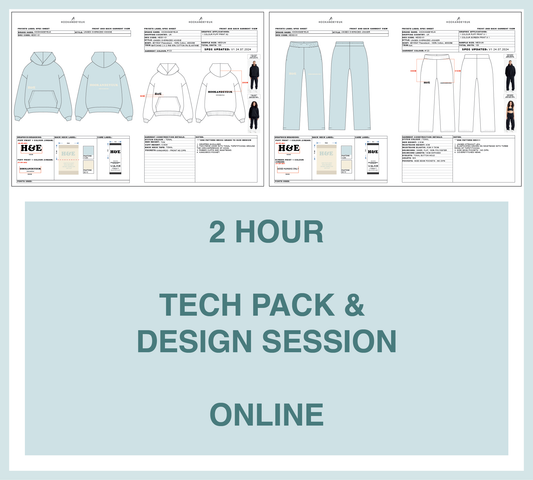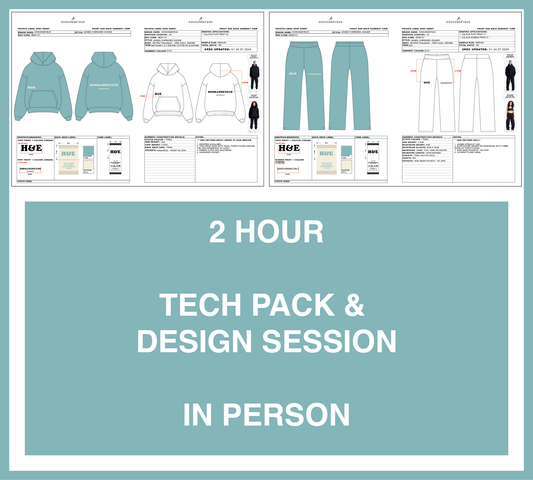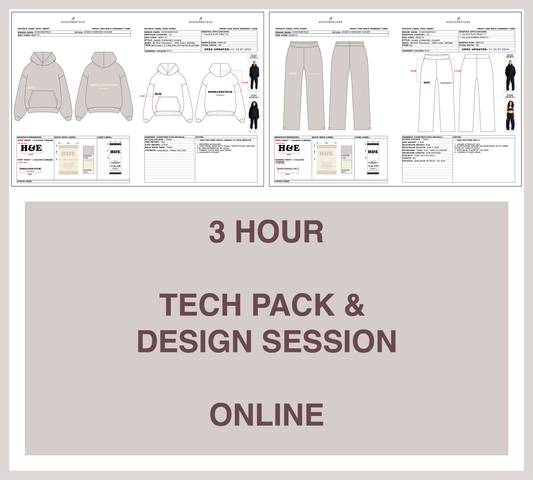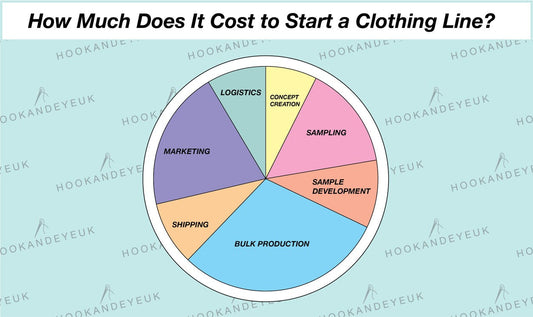How to Choose a Profitable Fashion Pricing Strategy (2024 Guide)
To be successful with your fashion brand, one of the most important things for you to work out is “how do I decide my RRP?”.
You probably started your clothing label out of a passion and love for fashion. But the fact of the matter is that your brand needs to be profitable in order to survive.
Setting the right fashion pricing strategy is possibly the single most important thing to get right if you want to make your clothing brand a lasting success.
Fashion brand pricing strategy - September 2024 Update
Now, because we love you guys, we’ve put together an Estimated Fashion Pricing Guide, with everything you need to know in order to correctly work out a pricing strategy for your garments. We update this every 6-12 months with fresh market research and realistic pricing estimations, and we've just released our latest version for September 2024.
This spreadsheet is completely free, and is absolute gold for anyone looking to set out a successful fashion pricing strategy.
Keep reading for more info!
Step 1: Download Our Free Estimated Fashion Pricing Guide for Accurate RRPs
We do a pricing analysis a couple of times a year where we take the average costing of the most popular garments and put them together in an excel sheet so you can see average costs for sampling, bulk manufacture, pattern cutting fees and shipping costs. This covers all the various sampling and bulk production costs you need to consider when working out your pricing strategy for your clothing brand.
This video explains how the fashion pricing guide is laid out! Check it out here:
And here's a sneak preview of the spreadsheet:

The guide is based on a quality level comparable with brands like Lululemon, Stussy, Represent, Joah Brown, ARIES etc.
If you are considering designing and manufacturing with Hook and Eye UK and you'd like a copy, drop me a note on Whatsapp: +447939591255 and I'll send it across.
This will give you an excellent basis to start making your pricing calculations.
Our pricing strategy tips don't end there though! Make sure to read to the very end of this blog to arm yourself with the clothing pricing strategy knowledge you need to make your clothing brand a success!
Step 2: Why Brand Positioning & Quality Should Define Your Fashion Price Point
For any start up clothing brand, we suggest that the best pricing strategy is to launch as a ‘bridge brand’. By that, we mean brands that sit somewhere in price between value brands (e.g. H&M, Hoodrich etc), and ultimate luxury brands (e.g. Prada, LV etc).

These are brands that 'bridge' that gap, so think along the lines of Stussy, Fear Of God Essentials, Palm Angels, Aries. Basically, really good quality streetwear and loungewear.
With high quality standards, you'll be able to sell your clothing to your customers at a higher price point than you would as a value brand. That means that your profits are much higher.
The only realistic way to start a value brand (where you have low cost garments that are at a reasonable quality) is to have very high Minimum Order Quantities (MOQ's), of around 2,000-3,000 pieces per design/colour. For most clothing startups, that just isn’t achievable, as it’s such a big capital outlay to produce such big orders.
So, all things considered, the rate of success for ‘bridge brands’ is much higher.
Here's a useful blog post explaining different brand levels, and how to position your clothing brand successfully.
Step 3: How Garment Design, Quality & Sampling Costs Impact Your Pricing
There are a lot of factors that should be considered when it comes to setting your Recommended Retail Price (RRP). You should of course take in to account the complexity of the garment, graphic applications used and the fabric chosen (i.e what the customer physically receives), but you should also consider the cost of your tech packs, cost of sampling, photoshoot and marketing costs, to make sure that you are fully covered and not running at a loss.
You might want to check out our guide on ‘The cheapest way to design clothes’. This is a fantastic guide on how to design in a simple but effective way that keeps your unit cost down.

When you sit down to work out your RRP per style, all of the above elements will have an impact and need to be considered.
Step 4: Why Starting High Builds Perceived Value & Protects Margins
The pricing that you set for your clothing really does impact the 'perceived value' in your customers' eyes. It's a simple equation. Higher priced items are often perceived as higher value. So don't be afraid of pricing your items at the right level!
For a bridge brand I always recommend an RRP of £140+ for a hoodie, £135+ for a Jogger and £60+ for a t-shirt. These prices set the tone of a good quality bridge brand. Don't be scared of them and don't worry about the people who scoff, only ever take advice from people who purchase from brands with similar designs and price points to what you'd like to achieve!

It’s very difficult to significantly raise your pricing further down the line, especially without completely losing the customer base you've already built up, so start as you mean to go on with pricing and don't sell yourself short. If you start selling your garments for £40/unit, and then later realise that you’re not making enough profit, it’s difficult to then raise them (your customers won’t be best pleased with a 30% price increase!).
But if you start at a higher price point, you can always offer special pricing with ‘friends and family’ discounts, or a slightly lower price if a customer is willing to place a larger order with you.
With higher pricing, you also have a buffer in case shipping costs start to erode your profit margin.
Step 5: How Shipping Method (Sea vs Air) Influences Your Clothing Pricing
Shipping costs are a factor that can fluctuate, so allow yourself some breathing room within your pricing strategy. Energy and fuel costs can suddenly rise so you need to work that into your fashion brand’s pricing strategy, and make sure that you’re still making enough profit.
There are 2 main types of shipping that fashion brands use - Sea Freight and Air Freight. The shipping method can have a massive impact on your costs.

Choosing a slightly longer shipping method for your bulk production is a great way to save costs. Sea freight is way cheaper and doesn't take much longer. Hook and Eye UK has a fantastic sea shipping method for your bulk production garments, it only takes 5-8 weeks depending on destination (most sea shipment is 10-12 weeks). As we have such a high volume of items being shipped for our collective brands it means we have much better shipping time frames than a single brand would!
You'd only ever go for air freight shipping if you were going to be fined by a store for delivering late products or if you were going to miss a specific event you've designed for, like Halloween.
Step 6: When to Hire a Fashion Pricing Consultant to Optimise Your RRP
At Hook and Eye UK, we’ve worked with hundreds of successful fashion brands over the years, helping to set RRPs and pricing strategies that lead to healthy bank balances and happy clothing brands.
We offer one-to-one brand consultations to help you set your fashion brand’s pricing strategy properly. This could make you £1,000's extra each year. If you think that would be useful, head over to our contact page and we can help from there, or you can find more info / book a one-to-one brand consultation here.
Conclusion: Building a Scalable & Profitable Fashion Pricing Model
Getting the pricing strategy right for your clothing brand is the single most important element in running a successful fashion business. Invest some time in market research and cost calculation to get it spot on and sustainable in the long term for your business model.
Our Estimated Pricing Guide is a great tool to help you factor in all the costs involved in manufacturing your clothing and work out a solid pricing strategy. The calculations are based on estimates of similar ‘bridge’ brands; if you're considering designing and manufacturing with us feel free to use it as starting point (drop us a Whatsapp +447939591255 to get your copy!).
The next thing to do is always think about the costs of production (including the whole process such as tech packs and sampling). The cost implications of different order sizes, fuel costs, exchange rates, and different shipping methods should also be taken into account; it all makes a big difference to how you should price your clothes.
Finally, if you need some professional assistance with getting your pricing right, Hook and Eye UK are here to help. Drop us a Whatsapp to see what we can do together to get your clothing pricing strategy spot on.
Love,
Joss H&E xx








